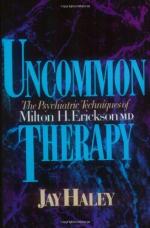
|
| Name: _________________________ | Period: ___________________ |
This quiz consists of 5 multiple choice and 5 short answer questions through Chapter 4, Character Revision of the Young Adult.
Multiple Choice Questions
1. Erickson's type of reinforcement in the example in Chapter 3 was incredibly effective and the _____ fell from the forefront into the background of the client's life.
(a) Headaches.
(b) Arrhythmia.
(c) Asthma.
(d) Appendicitis.
2. There may be fears, insecurities and inadequacies involved, but Erickson is not so interested in these or in explaining all about the shortcomings to the client, but rather Erickson focuses on helping the client to work towards what?
(a) Discussing their family.
(b) Releasing pent-up emotions.
(c) Unveiling their past.
(d) Success in other areas of life.
3. The period of adolescence that often closely predates major mating activity is one of the most important times for people to do what?
(a) Appreciate their families.
(b) Receive medication if needed.
(c) Branch out on their own.
(d) Receive any necessary therapy.
4. The transition from being a child into being an adult involves ______ of the relational patterns between family members.
(a) Dismissal.
(b) Manipulation.
(c) Removal.
(d) Rearrangement.
5. In Chapter 2, the author notes that among humans, the mating style appears to vary _____.
(a) Periodically.
(b) Innately.
(c) Culturally.
(d) According to society.
Short Answer Questions
1. The presence of a child or children creates a variant of the _____, which only grows in complexity with the advent of additional children.
2. Haley explains that in the most severe cases, Erickson would consider long-term therapy; otherwise, his relationship with clients lasted how long?
3. In most of the examples referred to in Chapter 3, success in dating leads not only into marriage, but also into ____.
4. After Erickson's client secured the job in Chapter 3, the therapist asked for details about how corrections were made when the client revealed that there had been _____.
5. Haley explains that Erickson, in dealing with ______, does not attempt to change their fundamental nature and does not even try to confront the real problem directly.
|
This section contains 314 words (approx. 2 pages at 300 words per page) |

|




